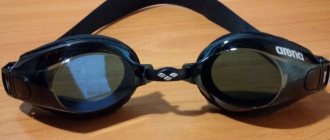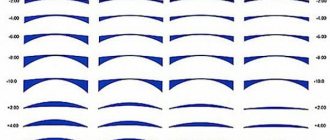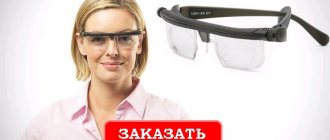Myopia, also known as myopia, is one of the most common vision pathologies along with hypermetropia and astigmatism. In this informational article we will talk about the features of the disease, how to choose the right glasses to correct myopia, and how to wear glasses correctly for myopia.
In this article
- Features of the pathology
- When and how to wear glasses for myopia?
- Are glasses for myopia a plus or a minus?
- What is better - lenses or glasses for myopia? Advantages and disadvantages
- What else do you need to know?
- How to choose glasses for myopia?
- Do I need to wear glasses all the time if I am nearsighted?
- Recommendations
Features of the pathology
According to experts, about forty percent of the population suffers from myopia, which is why the question of how to choose the right glasses for myopia is very relevant. Looking ahead, we will say that you can choose glasses only after consultation with an ophthalmologist, who will conduct an examination and be able to describe their parameters to you. So, what are the characteristics of myopia and why does it occur?
It has been established that in case of myopia, parallel rays after refraction are collected in front of the retina, that is, the main focus of the optical system does not coincide with the retina. Thus, it turns out that the eye is disproportionate, ametropic, since the length of the optical axis of the eye and the length of the focal length do not correspond to each other: either the refractive apparatus has a shorter focal length than the length of the eye (refractive myopia), or the length of the eye is longer than necessary for a given refractive power of the optical system (axial myopia).
In this regard, the following types of disease appear: mixed myopia (when the refractive error is caused by a deviation in both the axis length and the refractive power of the eye) and combination myopia. The latter depends on a peculiar combination of essentially normal elements of the optical ocular apparatus. At high degrees of myopia (above 6.0 diopters), axial myopia prevails, and at weak and moderate degrees, combinational myopia prevails. The following degrees of myopia are distinguished: first (up to 3 diopters), second (from 3 to 6 diopters) and third (more than 6 diopters).
When and how to wear glasses for myopia?
In the modern world, there are several options with which you can correct the existing disease. Perhaps the most innovative is wearing contact lenses. Today, manufacturers make them from soft hydrogel materials that are absolutely safe, allow oxygen to pass through and contain the optimal amount of moisture. But there are those people who still cannot feel comfortable when using lenses. Another method of correction is surgery. However, it is worth considering that in some cases it has only a temporary effect. There are also restrictions on age and the presence of other diseases. From all of the above, we can conclude that the safest correction method, although not the most comfortable from an aesthetic point of view, is the use of glasses.
Doctors also tend to believe that glasses are a safer and more affordable method than any other. Special glasses for myopia are equipped with concave lenses with a scattering effect. They refract light rays so that the focus of a particular object is directly on the surface of the retina. This characteristic allows you to see the object more clearly with well-defined contours.
Are glasses for myopia a plus or a minus?
Many people still wonder what lenses are available with glasses to correct myopia. The answer is obvious: with a minus. Let's decipher why. The fact is that in a person suffering from myopia, the focus of the image is in front of the retina, and not exactly on it, so objects at long distances are poorly visible. To eliminate the pathology, you need to shift the focus to the retina. This process is carried out using a concave lens with a “minus” sign (for farsightedness glasses there is a “+” sign).
Glasses in the fight against myopia
Myopia is a common problem associated with dysfunction of the visual system. According to statistics, a good half of humanity suffers from this disease. The most affordable way to eliminate the problem is to use glasses with specially selected lenses. These lenses are integrated into the frame shell in such a way that they create a diffuse effect due to the concave shape of the glass. Their action is based on the refraction of light rays so that the focus of the image being viewed is precisely on the retina of the eyeball. Thanks to this, a person sees much better.
Glasses for myopia
How to choose glasses? The answer to this question lies in the knowledge of imaging in myopathy. Namely: the picture is focused not on the retina, but under it . To move the focus to the retina, you must use concave lenses, which are indicated by a minus symbol. As a result, correction agents have a minus sign.
What is better - lenses or glasses for myopia? Advantages and disadvantages
We partially answered this question above, but it’s worth stopping and talking in more detail about the advantages and disadvantages of using glasses and contact lenses. Ophthalmologists say that a person with slight myopia can use both glasses and contacts only in certain cases. For example, for going to the cinema. If there is a third degree of the disease, then it is best to resort to contact lenses, since glasses are not able to provide one hundred percent vision. The above information is of a general nature, so only an ophthalmologist can answer the question of which correction method is best to choose (glasses or lenses). He will not only check your vision, but will also take into account your lifestyle, habits and characteristics of the body as a whole. It would not be amiss to say that glasses are considered the most affordable in terms of financial costs. In addition, one of the advantages is that constantly wearing them for myopia will not cause any complications. But there are also several significant disadvantages:
- changes in the field of visibility of the image are possible;
- often cannot guarantee 100% visual acuity, just like lenses;
- People often feel discomfort when choosing glasses.
Do glasses harm your eyesight?
Michael Duerr, an American ophthalmologist from Rochester Hills in Michigan, is convinced that the anatomy of the visual organs allows you to constantly wear glasses without losing your vision.
The main argument against wearing glasses is psychological. After a person takes them off, he feels discomfort. The picture around becomes less clear, and there is a desire to return everything back to make it better. It seems like there is an addiction. But this does not mean that vision deteriorates. Scientists from the American Academy of Ophthalmology have found an explanation for this phenomenon: the brain quickly gets used to receiving accurate signals, so it takes time for the system to break down and everything to return to normal. This does not mean that vision has deteriorated; on the contrary, over time the picture will be restored.
Lenses are needed to correct any visual abnormality. These include hyperopia (farsightedness), myopia (nearsightedness), and presbyopia (age-related farsightedness). And if you wear glasses all your life, and with age you discover that your vision has deteriorated - this is absolutely normal. There is a concept of “age-related farsightedness,” which is observed in people aged 40-50 years. The aging process affects the lens of the eye, causing it to lose elasticity and make it more difficult to focus quickly. In this situation, it is harmful to do without lenses; you need to go to the doctor. Visibility will improve if you use diopters with a plus sign. With myopia, another problem arises: the eye cannot see clearly in the distance, which also requires correction, since constant tension can lead to headaches and discomfort.
What else do you need to know?
To choose the right glasses for vision correction for myopia, you need to consider a few more points. There are special plus models recommended for myopia. Experts call this approach non-classical, since the glasses are equipped with lenses with smaller diopters. But the point is that this method allows you to relieve accommodative spasm, which contributes to the development of myopia. How is it possible to correct vision in this case? The fact is that improvement occurs due to an independent “fight” against the disease. Of course, this method is very specific and is not suitable for everyone, but you can still consult a doctor on this topic. If you are satisfied with this approach, then the ophthalmologist will tell you how to choose the right glasses of this type.
How to choose glasses with different diopters?
As mentioned above, you should not buy ready-made glasses. When purchasing them, you cannot correctly select the lenses you need.
There are no specific instructions from the doctor. If you have a large difference between your eyes, your optometrist will usually prescribe lenses of different dioptres with a lower rating. This recommendation is given to prevent eye disease from progressing. This is necessary to correct myopia or farsightedness.
How to choose glasses for myopia?
So, how to choose the right glasses for myopia? First, you should make an appointment with a specialist, who should conduct a thorough examination. He will determine the exact degree of vision loss, evaluate binocular vision, tell you what glasses will be used to correct myopia, whether minus or plus lenses are needed for this, and, if necessary, prescribe medications that will help relieve eye strain.
We remind you that it is extremely important that all of the above procedures are performed by a highly qualified ophthalmologist, since illiterate wearing of glasses for myopia can have a lot of consequences. Plus, the wrong choice of products for vision correction quite often negatively affects the success of treatment. After examination by a specialist, you can safely order glasses for myopia. The color and shape of the frame are selected taking into account individual preferences.
Is wearing glasses effective for myopia?
Using glasses to improve vision is the simplest and most affordable way that does not lead to complications. Read more about whether you should wear them in this article.
Among the disadvantages of spectacle vision correction are:
- The lens does not create a complete optical system, so visual acuity will not improve;
- Changing the field of view;
- Aesthetics.
However, without glasses it is very difficult for people with myopia to lead a full life, which is why attention should be paid to the correct selection of glasses.
Plus glasses for myopia - an unconventional method of treating myopia, consists of prescribing glasses with smaller diopters. It is believed that this method eliminates the spasm of accommodation, which is the main cause of myopia. According to doctors, weaker glasses can force the body to fight the disease on its own.
Computer glasses
Computer glasses are a preventative measure for vision correction when working at a computer. Designed to prevent visual syndrome that occurs when working at a computer for a long time. Regular glasses do not protect your eyes from computer radiation unless they have a special coating. They can cause eye irritation when standing in front of a monitor as they can distort the image.
That is why you should choose special glasses for computers for myopia, which can also be ordered with diopters. When choosing, you should take into account that for computer lenses you should choose 2 diopters less than for everyday ones.
The lens for computer glasses is equipped with an interference filter that effectively absorbs rays of the violet-blue spectrum and freely transmits sunlight.
Due to their optical characteristics, these glasses can reduce eye strain.
Sunglasses
Sunglasses - designed to protect the retina from burns. Ultraviolet radiation negatively affects the condition of human eyes. Prolonged exposure to bright sun can cause various diseases, including lens deformation, tissue burns, and decreased vision.
Ophthalmologists strongly recommend wearing sunglasses not only for people with myopia, but also for everyone for whom it is important to preserve their vision.
When choosing a model, you should take into account the fit of the glasses and the presence of an anti-reflective coating, because with poor-quality light reflection, rays can penetrate through the lens, causing a burn to the retina.
Do I need to wear glasses all the time if I am nearsighted?
A couple more questions that concern many people: is it worth wearing glasses for myopia all the time or can you take breaks? What glasses should be worn for high and other degrees? Ophthalmologists say the following: if the stage is not very high, glasses should be used regularly to prevent severe strain on the eye muscles and loss of vision. However, there may be exceptions, especially if we are talking about some type of work. For example, you can work without glasses at a distance of no more than 40 centimeters. With a high degree of myopia, it is necessary to regularly wear glasses, and special ones. At the same time, ophthalmologists recommend resorting to several types at once. For example, models for constant wear for myopia, if necessary, can be replaced with glasses for reading and writing.
Night myopia - what is it and do you need to wear glasses?
This form of myopia is not a pathology. It occurs in people who do not have vision problems. At the same time, it is observed in many people, but not everyone notices it. When a person enters a dark room, his pupils dilate. The refractive power of the lens increases, as a result of which light rays entering the eye appear in front of the retina, and not on it, as happens with myopia. Of course, you don't need to wear glasses. Night myopia is just a protective reaction of the body to changes in lighting levels.
Recommendations
What is also important to know in order to choose glasses for myopia? If you put on glasses and the picture before your eyes is unclear, this is the first sign that the optics are chosen incorrectly. Plus, it’s worth remembering the following points:
- eyes wearing glasses should not be strained and get tired quickly;
- You should not be overcome by nausea and dizziness.
If at least one of the above signs bothers you, and the situation does not change within a week, then you need to contact a specialist. Perhaps you were prescribed glasses with the wrong lenses or you have an individual intolerance. The problem may also be due to incorrect placement of the optics in the frame.
There are some more facts that are worth remembering in order to know how to properly wear glasses for myopia.
Remember that in the presence of astigmatism and myopia, a special type of myopia glasses with cylindrical lenses is prescribed. It will also be difficult to correct anisometropia with glasses, that is, an anomaly in which the eyes have different optical powers. Lazy eye syndrome may begin to develop, and correcting the problem with glasses will be much more difficult. You will have to prescribe another type of treatment.
Lazy eye also develops in young preschool children with incomplete correction of a high degree of myopia. Low vision cannot be restored, and the success of treatment can only be guaranteed by prompt and complete vision correction. Summarizing all of the above, we draw a conclusion. Myopia is a problem for many people of different age groups. But modern medicine makes it possible to diagnose this disease in a timely manner almost always (including at an early stage) and correct the disease.
Despite the fact that many people currently prefer lenses, glasses for myopia still remain in high demand. They are prescribed to preschool children and adolescents, and adults also wear them. Do not delay your visit if you feel discomfort, do not risk your vision and the health of your body as a whole.
How to get used to glasses
Description
When you put on glasses for the first time or change from one pair of glasses to another according to a new prescription, what you see through them will initially irritate you a little.
Of course, you expected that you would see everything more sharply and clearly, but at the same time you feel some strange side effects. Visible objects may seem larger or smaller than usual, closer or further, their familiar contours seem slightly deformed. Don't panic - these effects will soon pass, and after a few days you will no longer notice them. But why does this problem even arise? There are several reasons for this. For technical reasons, there is an exact match with the parameters prescribed for your eye in only one place of the spectacle lens - in its very center. If you do not look through the center of the lens (and you do this every time you shift your gaze), then in fact you are looking through a lens with slightly different parameters. The difference increases towards the edge of the lenses - it is this that causes a slight distortion of the contours and sizes of visible objects. The thicker the lens, the greater this difference can be; The larger the lens, the greater the distortion at its edge (the eye is significantly further from the edge of the lens than from its center). With not very large diopters, this distortion is quickly compensated by the brain, and you can easily adapt to it. With strong glasses, this adjustment is quite difficult, so it is better to avoid glasses that are too large.
Another factor that affects your vision through glasses is the degree of curvature of the lens surface. It is possible to produce lenses of the same power but with different degrees of curvature. They can be made flat on one side, then they will be plano-convex, but convex-concave ones are more often used. What follows from this? The degree of curvature of the lenses affects the size and shape of the image visible through them. For example, concave lenses for myopia will produce a larger image if made with a greater curvature. If your eyeglass prescription is very different for each eye, it is not at all easy to find the correct curvature for both lenses. Has it ever happened to you that through two seemingly identical pairs of glasses you see slightly differently? It may well turn out that they are made with lenses of different curvatures.
If you are nearsighted and you are putting on glasses for the first time, then the world around you seems clear to you, but somehow somewhat reduced. Since the brain uses the concept of size as one of its means of determining the distance to objects (small objects are assumed to be far away), in this situation you will perceive all objects to be further away from you than they actually are. So, you can even knock over a cup of coffee by stretching out your hand to it - it turns out to be closer than you thought.
If you are farsighted, the opposite effect occurs. Objects appear clearer, but somewhat larger. Therefore, you will believe that the object is closer to you, and trying, for example, to press the bell button, at first you will not reach it. After a few days, the brain will learn to calculate the correction for the “object/distance to it” ratio, and you will again be able to operate with the usual concepts of distance.
Such troubles may seem trivial compared to those that arise when you first put on glasses to correct astigmatism. Objects in this case will seem curved and blurry, the entire field of vision will seem completely unfamiliar, chaotic (you will feel something like Alice in Wonderland). However, be brave - no matter how strange the objects may seem, very soon, within a few days, they will turn into a “normal” looking world.
Modern scientific and technological advances in the field of refractive materials have made it possible to produce thin, almost weightless lenses from polymers. The higher the refractive index (refraction) of the material from which the lens is made, the greater the refractive power that can be achieved at any given point. As a result, it was possible to achieve revolutionary changes in the appearance of glasses. However, due to the increase in refractive power, shifting the gaze from the center of the lens causes a more rapid change in the parameters of this refraction, and therefore getting used to such glasses may take longer, but it is worth it.
The size of the image can be influenced by such a seemingly insignificant detail as the distance between the lens and the eye. If you are farsighted and your glasses have slipped onto the tip of your nose, the image size increases. With myopia, in this case, its size decreases. The exact amount of these changes depends on the length of your nose and the strength of your glasses.
All these initially annoying symptoms are proportional to the strength of the glasses assigned to you. A very nearsighted person has to put up with very thick, reflective lens edges. Their thickness can be somewhat reduced through the use of special polymer materials, and additional improvements can be made by “rounding” the edges and shading the lenses themselves. It is best to match them to smaller frames, since the thickness of the edges increases sharply with increasing lens size.
A very farsighted person does not care at all about the thickness of the edges, but the eyes in such glasses, due to the increased thickness of the center of the lens, appear “bulging”, and the person appears “goggle-eyed”. This trouble can be largely overcome with the help of glasses made of special polymer materials, the curvature of the lenses in which is such that. Of course, it will take longer to get used to them.
Some people are concerned that light is reflected from glasses, especially at night. Eventually you get used to it, but if desired, such reflection can be reduced by applying a special multi-layer anti-reflective coating to the surface of the lenses.
In order to get a good image, the center of the lens must be exactly in front of the pupil. Very rarely, the size of the frame allows this to be achieved, and therefore the lenses are slightly shifted taking into account the actual position of the eye (Fig. 27).
If this is not done, the focusing of the eye and its movements will be impaired.
From all of the above it should be clear that glasses cannot be chosen “at random”. Vision examinations and glasses selection must be carried out carefully and competently. For your own good, it is better that all this happens under the supervision of an ophthalmologist.
Handling and caring for glasses
To ensure that your glasses are always in good condition, you need to follow certain rules for handling them. Put them on and take them off with both hands, holding them by the arms. Do not try to reduce the bend of the arms, which is especially common for women in their desire to maintain their hairstyle. Never place glasses with the lenses facing down as this may cause scratches on the lenses. You need to put your glasses on the temples or put them in the case.
All kinds of dirt usually collect in the gaps between the frame and the edges of the lenses. It can be easily cleaned with an old toothbrush and washed with warm water and soap.
If you have plastic lenses, even “scratch-resistant” ones, dirt from them also needs to be removed; Before wiping your glasses with a soft cloth, it is better to rinse them. If there is no water nearby, then it is better not to wipe the glasses dry, but simply blow off the dust from them.
No matter how careful you are, it is always possible that the frame will break, crack or bend. In this case, in order to avoid inconvenience and visual impairment, it is imperative to return the frame to its original condition, which is done at the place where the glasses were purchased. In the USA, the price of this service is usually already included in the price of glasses.
Article from the book: Vision, glasses and contact lenses | Solomon G., Zinn W..











